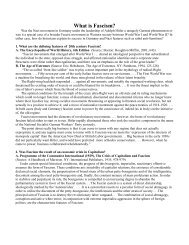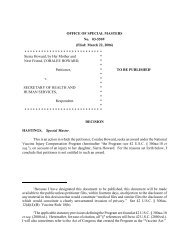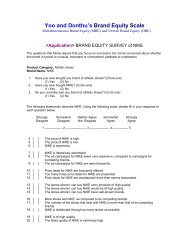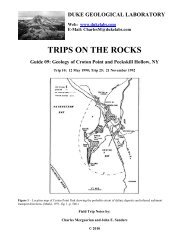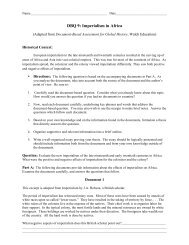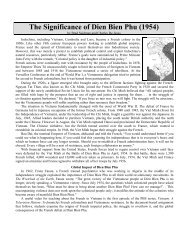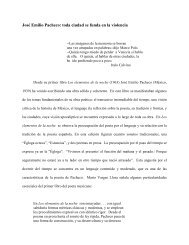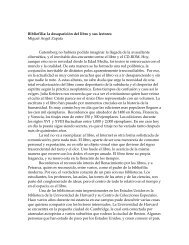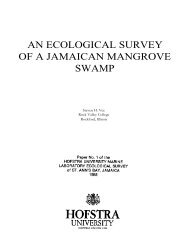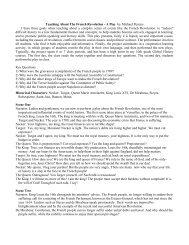Hydrology Lecture Notes – Water Chemistry - Hofstra ... - People Page
Hydrology Lecture Notes – Water Chemistry - Hofstra ... - People Page
Hydrology Lecture Notes – Water Chemistry - Hofstra ... - People Page
Create successful ePaper yourself
Turn your PDF publications into a flip-book with our unique Google optimized e-Paper software.
<strong>Hydrology</strong> <strong>Lecture</strong> <strong>Notes</strong> <strong>–</strong> <strong>Water</strong> <strong>Chemistry</strong><br />
Contaminant Concentration<br />
Groundwater is never pure, rather it contains small amounts of dissolved gases and<br />
solids.<br />
Chemical analysis of an aqueous solution yields the amount of solute in a specified<br />
amount of water. There are several ways this is reported:<br />
Weight per Weight units (dimensionless ratios): ppm, ppb, ppt (parts per million,<br />
billion, trillion). These are no longer commonly used in water analysis, although they are<br />
sometimes reported to the public because they are easy to interpret.<br />
Weight per Volume units: milligrams per liter (mg/L) and micrograms per liter (ug/L).<br />
These are more commonly used.<br />
1 liter of pure water = 1X10 6 milligrams H2O at 3.89°C therefore 1 ppm = 1 mg/L<br />
Note: density and weight of water will change with temperature and dissolved mineral<br />
matter, but not enough to worry about within the range of normal groundwater<br />
conditions.<br />
Legal Limits on Concentrations:<br />
MCL (Maximum Contaminant Level) <strong>–</strong> the highest level legally permitted in<br />
groundwater.<br />
MCLG (Maximum Containment Level Goal) <strong>–</strong> the level of contaminant below which<br />
there is no known risk. The ideal level, lower than the MCL.<br />
AL (Action Level) <strong>–</strong> The concentration of a contaminant at which action must be taken to<br />
treat it.<br />
ND <strong>–</strong> Non Detect <strong>–</strong> contaminant not detected given sensitivity of the test.<br />
<strong>Chemistry</strong> Measures of Concentration<br />
Molarity is the number of moles of solute dissolved in one liter of solution (moles/L).<br />
The units, therefore are moles per liter, specifically it's moles of solute per liter of<br />
solution.<br />
One Mole of a chemical species is its formula weight in grams, calculated by adding up<br />
the atomic weights of all the atoms in that species. E.g. NaCl = Na (at.wt. 22.991) + Cl<br />
(at.wt. 35.457) = 58.448 gm.
Thus, a 1 molar solution of NaCl would be 58.5 grams of NaCl dissolved in 1 Liter of<br />
water.<br />
Sample Calculations:<br />
1. What is the molarity of a solution made by dissolving 2.5 g of NaCl in enough water to<br />
make 125 ml of solution?<br />
molarity = moles of solute / liters of solution<br />
2.5 g NaCl x (1 mole NaCl / 58.5 g NaCl) = 0.0427 mole<br />
molarity = 0.0427 mole NaCl / 0.125 L = 0.34 M NaCl<br />
2. How many moles of salt are contained in 300. mL of a 0.40 M NaCl solution?<br />
0.40 moles NaCl / 300 mL = 0.4 moles x .3 L = 0.12 moles NaCl<br />
Molarity: 1 mole per liter of solvent = 1 molar solution<br />
Molality: 1 mole per 1000 grams of solvent = 1 molal solution<br />
molality (M) = moles solute / kg of solution<br />
For water solutions, 1 kg of water has a volume close to that of 1 liter, so molality and<br />
molarity are similar in dilute aqueous solutions <strong>–</strong> up to .01 molal.<br />
Thus for dilute solutions, you can calculate Molarity or Molality as:<br />
Molal / Molar = mg/L X 10 -3 / formula wt in grams<br />
Example:<br />
48 mg/L NaCl = ? molality<br />
48 mg/L x 10 -3 / 58.5 = .00082 molal / molar<br />
Equivalent Weight units incorporate the chemical behavior of a solute. The equivalent<br />
weight or combining weight of a dissolved ionic chemical species is the formula weight<br />
divided by the electrical charge.<br />
Example: A divalent ion (Ca+2) combines with Cl- (a monovalent ion) to form calcium<br />
chloride (CaCl2). The combining ratio of calcium to chlorine is one-to-two, meaning it<br />
takes half a mole of Ca +2 to combine with one mole (or 1 eq) of Cl - . So, half a mole of<br />
calcium equals 1 equivalent.
Another way to look at it is to say one equivalent is the amount of ion required to cancel<br />
out the electrical charge of an oppositely charged monovalent ion. You can also say that<br />
the valence charge of the ion is the number of equivalents there are in one mole of that<br />
ion. For example, nitrogen (N -3 ) is a trivalent ion; therefore one mole of nitrogen equals 3<br />
equivalents. Using the calcium example from above, we know that one mole of calcium<br />
equals 2 equivalents.<br />
The amount of a given substance in equivalents is equal to the amount of the<br />
substance in moles multiplied by the valence of the substance.<br />
The equivalent weight is the mass of one equivalent of a substance.<br />
Example:<br />
1 mol H2SO4 = 2 equivalents H2SO4<br />
There are "TWO" H+ released when the acid dissociates<br />
The acid releases two H+ ions and one SO4 2- ion.<br />
Thus 1 equivalent weight of sulfuric acid is 1/2 the mass of a mol.<br />
1 mol H2SO4 = 98 grams H2SO4; 1 equivalent H2SO4 = 49 grams H2SO4<br />
In practice, the amount of a substance in equivalents often has a very small magnitude, so<br />
it is frequently described in terms of milliequivalents (mEq or meq) -- the prefix milli<br />
denoting that the measure is divided by 1000. Very often, the measure is used in terms of<br />
milliequivalents of solute per liter of solvent (mEq/L).<br />
Example:<br />
1 mol H3PO4 = 3 equivalents H3PO4<br />
The acid releases three H+ and one phosphate PO4 2- ion.<br />
The equivalent weight of phosphoric acid is 1/3 the mass of a mol.<br />
1 mol H3PO4= 98 grams H3PO4; 1 equivalent H3PO4= 32 grams H3PO4<br />
The relation between equivalents and milliequivalents:<br />
1 equivalent H3PO4= 1000 milliequivalent H3PO4<br />
1 equivalent mol H3PO4= 32 grams H3PO4;<br />
1 milliequivalent mol H3PO4= 32 milligrams H3PO4;<br />
Shortcut:<br />
Dividing the concentration in mg / L by the equivalent weight of the ion (one equivalent)<br />
yields a concentration in milliequivalents per L (meq/L). Non ionic species such as<br />
silica cannot be expressed in meq/L.<br />
Example:<br />
Ca 2+ = 40.08 gm/mole = 2 equivalents<br />
1 equivalent = 20.04 gm<br />
134 mg/L of Ca 2+ = 134 mg/L / 20.04 gm = 6.69 meq/L
Equivalents have advantage over moles in quantitative analysis of reactions. The best<br />
feature of using equivalents is that there is no need to study much about the nature of<br />
reaction, i.e. no need to analyse and balance chemical equations. Equivalents of reactants<br />
react in equal numbers to yield the same equivalents of products.



